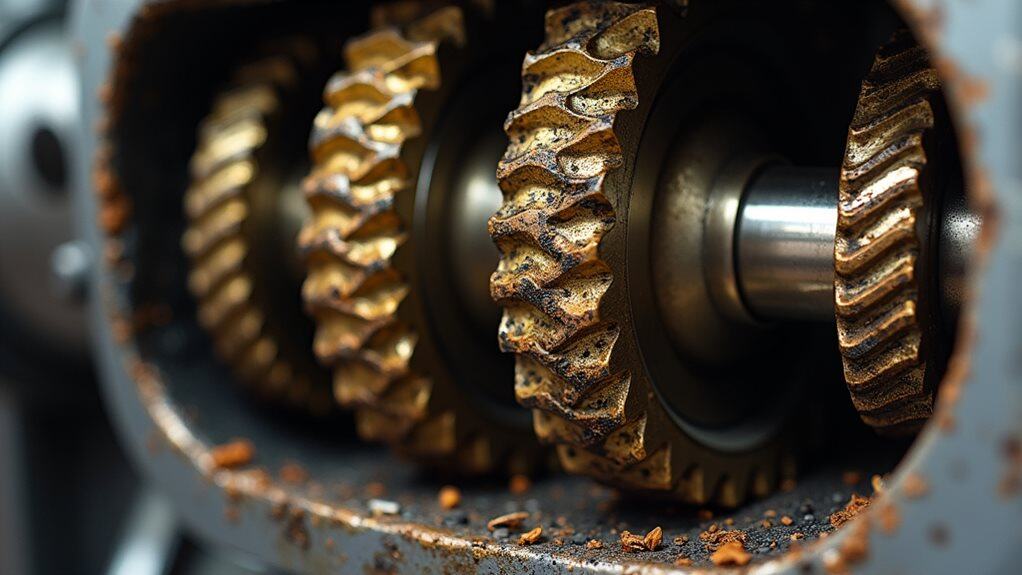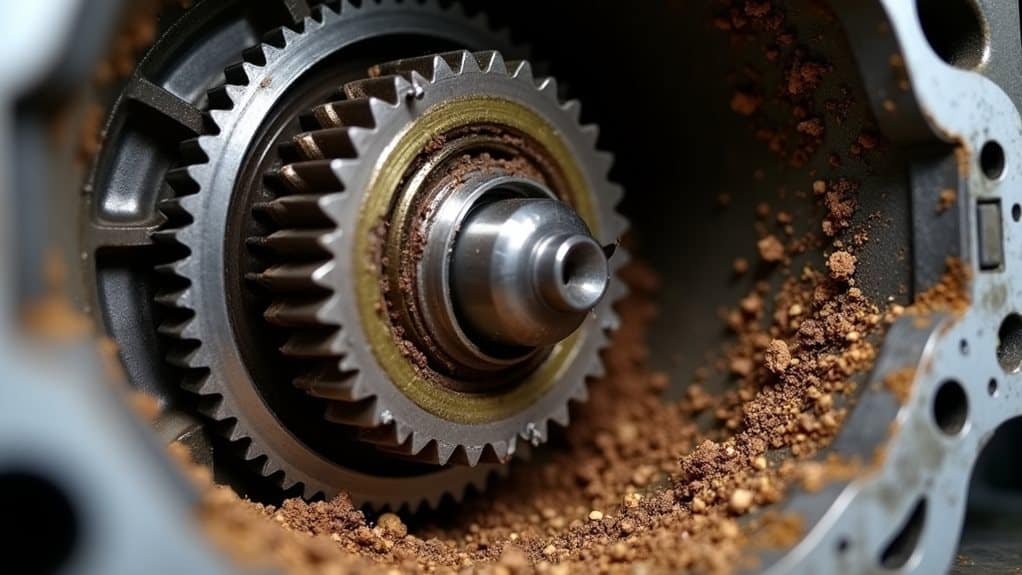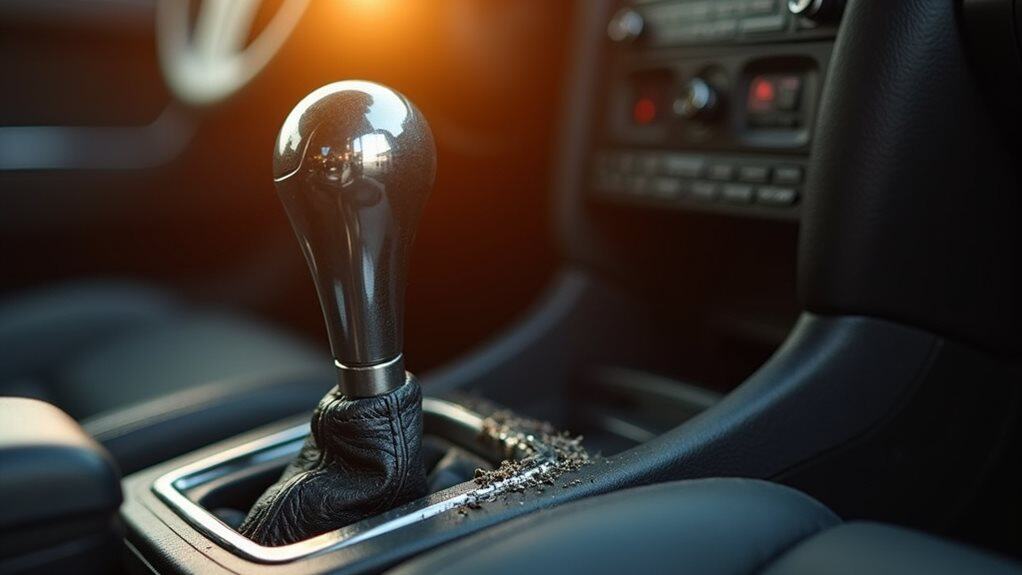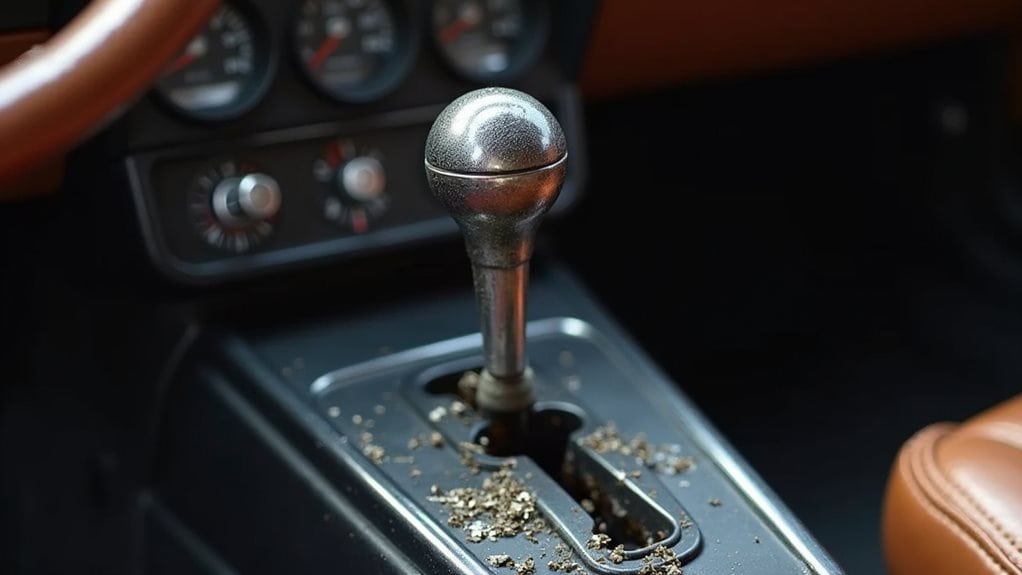Bad transmission synchros typically reveal themselves through grinding noises when shifting gears, especially into first or reverse. You’ll notice increased difficulty in gear changes, requiring more force or double-clutching to engage. Watch for unexpected jumps to neutral, persistent shifting delays, and unusual clunking during downshifts. These symptoms not only affect your daily driving experience but can lead to complete transmission failure if ignored. Understanding these warning signs helps prevent costly repairs and safety risks.
Quick Tips
- Grinding noises during gear changes, particularly when shifting into first gear, indicate worn synchronizers requiring immediate attention.
- Difficulty engaging specific gears or unexpected jumps to neutral while driving suggests failing synchro mechanisms.
- Dark or foamy transmission fluid accompanied by harsh shifting sounds signals deteriorating synchronizer performance.
- Persistent delays in gear engagement and the need for double clutching points to synchronizer wear.
- Clunking noises during downshifting and transmission fluid leaks are clear warning signs of synchro failure.
Understanding Transmission Synchros and Their Function

When you’re driving a manual transmission vehicle, synchronizers work behind the scenes to make your gear changes smooth and effortless. These essential components act as friction clutches within your transmission, matching the speed of the input shaft to your desired gear. You’ll find various types of synchros, from single-cone to triple-cone designs, all working to prevent gear grinding and guarantee seamless shifting. The introduction of two-part dog clutches revolutionized gear shifting by providing more precise engagement control. Proper maintenance of transmission fluid levels is crucial for the longevity and performance of these components.
Common Grinding Noises During Gear Shifts
Grinding noises during gear shifts serve as clear warning signs that your transmission needs attention.
If you’re hearing these sounds, they’re likely caused by worn synchronizers failing to match gear speeds properly, or a clutch that’s not fully disengaging. Low transmission fluid can also lead to increased gear grinding during shifts. Additionally, it’s crucial to check for transmission fluid issues that may exacerbate the problem.
You’ll often notice this grinding most when shifting into specific gears, especially reverse, and it’ll worsen if you don’t address the issue promptly.
Warning Signs of Failing Synchros

Your vehicle’s transmission synchros will typically display several telltale signs before complete failure.
Watch for slight grinding noises during gear changes, especially when shifting into first gear.
You’ll notice the transmission becoming increasingly difficult to shift, often requiring double clutching.
If you’re experiencing unexpected jumps to neutral or persistent shifting delays, don’t ignore these warning signs. Regular checks on the starter motor can save on costly repairs.
Impact on Daily Driving Experience
Driving with faulty synchros can convert your daily commute into a challenging and potentially hazardous experience.
You’ll notice grinding noises during gear changes, and you might struggle to shift smoothly, especially when merging onto highways.
The erratic gear engagement can cause unexpected stalls and compromise your vehicle’s speed control, making routine maneuvers like highway merging considerably more dangerous. Additionally, issues such as hard shifting can exacerbate these problems, leading to further complications in your vehicle’s transmission performance.
How Bad Synchros Affect Vehicle Performance

When your vehicle’s synchros start to fail, you’ll notice immediate changes in how your car performs during gear shifts, particularly when you’re trying to maintain consistent speeds.
Your transmission will require more effort to engage gears smoothly, and you might find yourself struggling with gear selection, especially during vital moments like merging or passing other vehicles.
These shifting difficulties put additional stress on your transmission’s components, which can lead to accelerated wear and potential damage to other parts of your drivetrain if left unaddressed.
Gear Shifting Becomes Difficult
As synchronizers begin to fail in your transmission, one of the most noticeable symptoms you’ll encounter is increasingly difficult gear shifting.
You’ll find yourself using more force than usual to move the gear shift lever, and certain gears may refuse to engage unless you’ve completely stopped.
If you’re experiencing these issues, you might need to resort to double-clutching, even in modern vehicles.
Speed Control Issues
Bad synchronizers greatly impact your vehicle’s speed control, creating a cascade of performance issues that affect both safety and drivability.
You’ll notice inconsistent shifting patterns and grinding noises when changing gears, which leads to reduced acceleration and unpredictable vehicle behavior.
Additionally, your car’s stopping distance may increase, and you’ll experience diminished responsiveness that can make driving dangerous, especially in demanding situations.
Transmission Stress Increases
Failing synchronizers in your transmission create a domino effect of mechanical stress throughout the entire drivetrain system.
You’ll notice grinding noises during gear shifts and increasing difficulty engaging gears.
When your transmission’s synchros deteriorate, you’ll need to double clutch more frequently, which puts additional strain on your clutch assembly.
If left unchecked, these issues can lead to complete transmission failure.
Safety Risks of Driving With Worn Synchros

When you’re driving with worn synchros, you face the serious risk of unexpected gear disengagement, which can leave you without proper control of your vehicle’s speed at vital moments.
Your transmission might suddenly pop out of gear during acceleration or while climbing hills, creating dangerous situations where you can’t maintain consistent speed or power.
If you notice any resistance or grinding when shifting gears, it’s essential to address the issue immediately, as these symptoms indicate your synchros are failing and putting your safety at risk.
Unexpected Gear Disengagement Dangers
Three major dangers arise when driving with worn synchros that can lead to unexpected gear disengagement.
First, you’ll experience harsh shifting that can cause immediate loss of vehicle control.
Second, your transmission may slip unexpectedly, especially during critical driving moments.
Finally, your vehicle could stall without warning, particularly during gear changes, putting you and others at serious risk on the road.
Sudden Speed Control Loss
Driving with worn synchros can lead to dangerous losses in speed control, creating serious safety hazards on the road.
You’ll notice your engine’s power suddenly dropping during gear changes, making it difficult to maintain consistent speeds.
When downshifting, you might experience grinding that disrupts smooth deceleration, while erratic gear engagement can cause unexpected jolts or stalls, compromising your vehicle’s stability and control.
Diagnostic Steps for Synchro Problems
Accurate diagnosis of synchronizer problems requires a systematic approach to identify the root cause of transmission issues.
You’ll need to perform a visual inspection of synchronizer sleeves, check transmission fluid quality, and listen for grinding noises during shifts.
Monitor your gear engagement closely, noting any difficulty or resistance, and test the clutch’s condition before assuming synchro failure.
Professional Repair Options and Costs

When transmission problems arise due to faulty synchronizers, you’ll need to contemplate several professional repair options and their associated costs.
You can start with a diagnostic assessment, where technicians will identify worn components and recommend solutions.
Consider fluid changes with cleaning additives as a first step, but if issues persist, you’ll have to choose between synchro replacement or complete transmission rebuilding.
Preventing Premature Synchro Wear
You’ll find that proper shifting techniques, including smooth gear changes and avoiding forced shifts, are crucial for protecting your transmission’s synchros from premature wear.
Regular maintenance of your transmission fluid, including checking levels monthly and changing it according to your vehicle’s maintenance schedule, will greatly extend the life of your synchros.
When shifting gears, you should always verify complete clutch engagement and wait for RPMs to match before selecting the next gear, as this practice helps prevent unnecessary strain on your synchronizers.
Proper Shifting Technique Tips
Learning proper shifting techniques stands as the foundation for preventing premature synchro wear in manual transmissions.
You’ll need to fully depress the clutch before shifting and maintain smooth movements when changing gears.
Shift at ideal RPMs between 2,500-3,000, and don’t force the gear lever if you feel resistance.
Always use gentle movements to protect your transmission’s synchros from unnecessary wear.
Transmission Fluid Maintenance Rules
Maintaining proper transmission fluid levels and quality serves as a critical defense against premature synchro wear.
You’ll want to check your fluid monthly if you have a dipstick, looking for a clean red or pink color. Fresh fluid guarantees smooth shifts and proper component lubrication, while dark or foamy fluid indicates it’s time for a change.
Don’t risk using incorrect fluid types, as this can void warranties.
When to Replace Your Transmission Synchros

While transmission synchros can endure years of regular use, knowing the right time to evaluate them is essential for maintaining your vehicle’s performance and preventing costly repairs.
You’ll need to assess replacement when you notice persistent grinding during shifts, experience frequent hard shifting, or hear unusual clunking noises while downshifting.
If you’re seeing transmission fluid leaks or your gears keep popping into neutral unexpectedly, don’t wait to address these issues.
Wrapping Up
When you’re dealing with synchro problems, don’t wait until they become severe. Listen for grinding noises, pay attention to gear-shifting resistance, and monitor your transmission’s behavior. Taking action early can save you thousands in repairs and prevent complete transmission failure. Regular maintenance, proper shifting techniques, and prompt attention to warning signs will help extend your synchros’ life and keep your manual transmission running smoothly for years to come.

